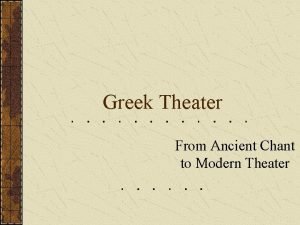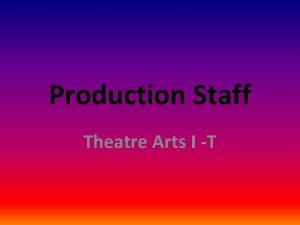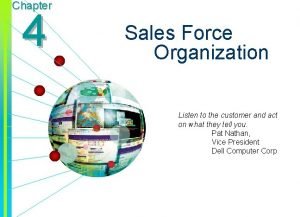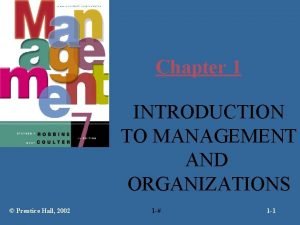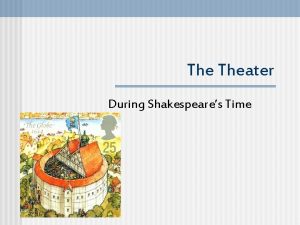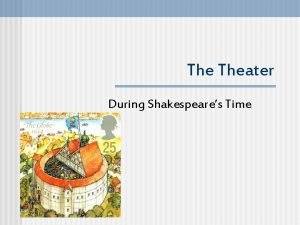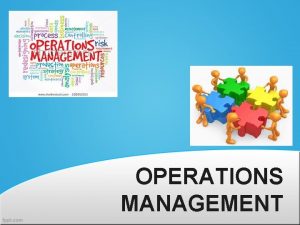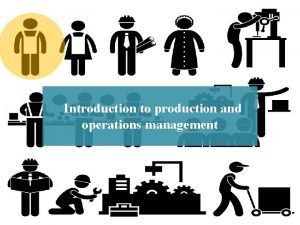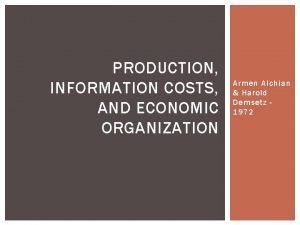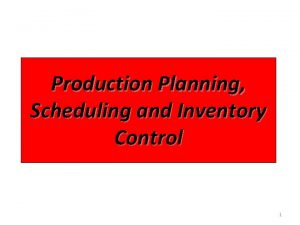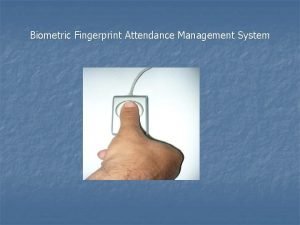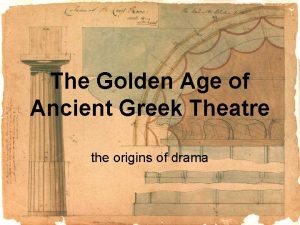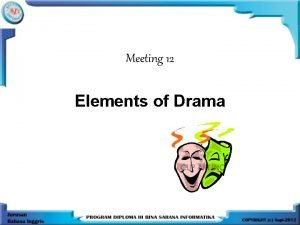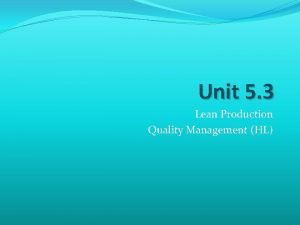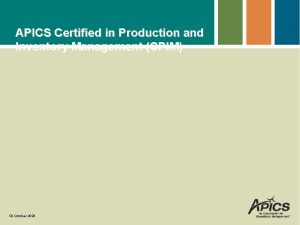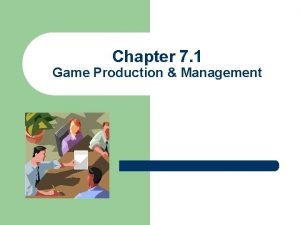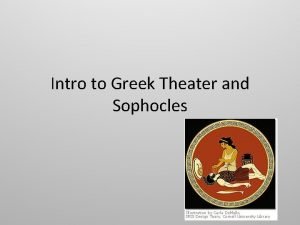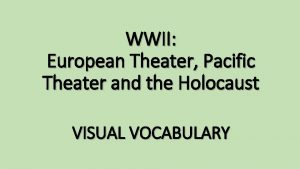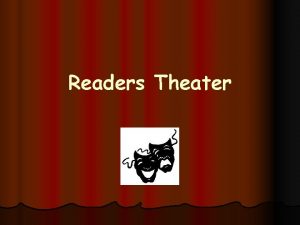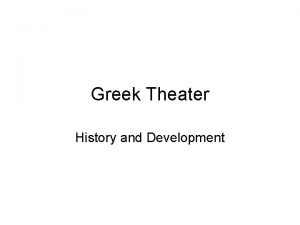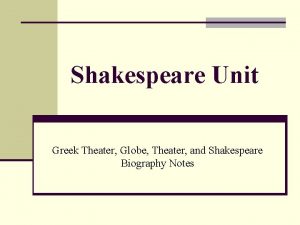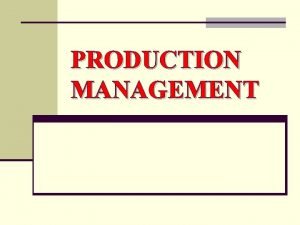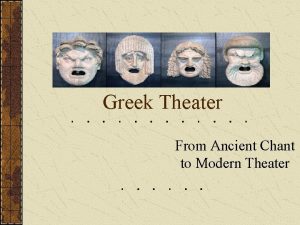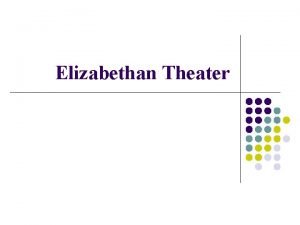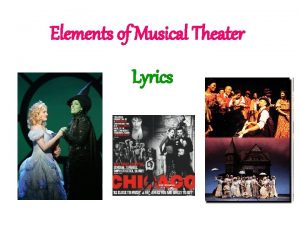Production Organization and Management Staff Introduction to Theater























- Slides: 23

Production Organization and Management Staff Introduction to Theater Organization and Brief Job Descriptions

“Theatre folk have always delighted in surrounding the process of putting on plays with an aura of mystery. The tradition stems from the probably accurate belief that a play’s entertainment value increases if the audience thinks that the production spontaneously happens. ” -J. M. Gillette

Going from the page to the stage takes planning, time, effort, and a lot of challenging work. The PRODUCTION TEAM works hard to create a product that is meaningful and artistic but also appears to be seamless.

Good Theatre requires good organization Every successful production has a strong organizational structure. Each company’s structure is unique to its own needs but they tend to follow a pattern.

This is specific to this company

Production Meeting The PRODUCTION MEETING or “Prod Meeting” is probably the single most important device for ensuring smooth communication among the various Production Departments. The production meetings tend to happen once a week to keep everyone on the same page as the production develops

Who attends the Production Meetings? Usually only the top tiers of the organization attend the production meetings. That being said, it is still a conference of 11 -14 people Typical Production Team is made up of Director, Playwright, Production Manager, Technical Director, Designers, Prop Master, Stage Manager, and Managing Director

Production Time line Every company operates on a different schedule, but the following is a base time line of a production of a professional company 4 weeks of Concept/ Design Meetings and Planning 6 weeks of rehearsals and construction 1 week of Tech and Dress Rehearsals 2 Weeks of performance Total from concept to closing= 13 Weeks

Producer or Board of Directors The Producer is the ultimate authority in the organizational structure of a theatrical production. The producer secures the rights to the play, leases theater, hires the director, and production staff, and is the financial backing of the production. Sometimes this job is the responsibility of a few people who make up a Board of Directors

Managing Director The M. D. deals with all the business aspects of the production. The are responsible for acquiring and managing funds for contracts, fundraising, ticket sales, publicity, and box office management.

Playwright The playwright creates and develops the ideas that evolve into the finished script. If available the playwright will often help the director explaining their interpretations of plots and characters

Director The director is the artistic manager and inspirational leader of the production team. The director coordinates the work of the actors, designers, and crews so that the production accurately expresses the production concept. The director is ultimately responsible for the unified creative interpretation of the play as it is expressed in production

Stage Manager A good stage manager is essential to running a successful production. They keep a production moving forward by anticipating problems and keeping open communication between all departments. They assist the director during rehearsals and are responsible for all backstage activity after the show opens.

Scenic Designer The scenic designer is responsible for the visual appearance and function of the scenic and property elements in a production Through research and renderings they convey the concept to the technical director.

Scenic Artist The scenic artist, under the direction of the Scene Designer, is responsible for the painting of the scenery. They have to be able to work with many different mediums on a wide range of materials on a large scale.

Property Master (Prop Master) The Property Master is responsible for the design and construction of the various decorative and functional props that are used in a production

Technical Director In smaller theaters, the T. D. , may just be responsible for the construction, transportation, and installation of all scenery and properties on the stage. Larger theaters may have multiple venues, simultaneous shows, and multiple crews that report under a T. D. The T. D. will facilitate communications of the production teams, keep track of construction process, oversee budgets, and manage crews.

Lighting Designer The lighting designer is responsible for the design, installation, and operation of the lighting and special electrical effects used in a production To show where lighting equipment will be placed they create a light plot showing where lights will go in theatre

Costume Designer The Costume Designer is responsible for the visual appearance of the actors. They create costume renderings to reinforce the directors concept with also giving the audience visual information about a character (age, gender, social class, occupation)

Sound Designer The sound designer is responsible for the design, recording, equipment set up, and playback of any sound used in a production. The are also responsible for the reinforcement of sounds made by the actors on stage

Personnel Each department has multiple crews that work together to mount a show Assistant Stage Managers, Paint Crews, Props Crew, Run Crew, Master Carpenter, Construction Crew, Assistant Designers, Master Electricians, Stage Electricians, Costume Shop Supervisor, Costume Crew, Sound Crew, Box office crew, and House Staff all work under the guidance of the Production Team

Challenge Take a moment in your notebook to create an organization Box chart for the Quincy High production staff Be sure to include the following Producer, Director, Designers, Stage Managers, Box Office, Performers, Run Crew, Construction crew, Technical Directors, Costume Crew, Scenic Artist, and Props Management Under the job title write in the name(s) of who currently fills those roles. (Teacher, Student, Parent, Administrator)

 Greek theater vs modern theater
Greek theater vs modern theater Proses produksi multimedia
Proses produksi multimedia Playwright
Playwright Staff sales organization
Staff sales organization Introduction to management and organization
Introduction to management and organization Hamlet part 1 an introduction to elizabethan theater
Hamlet part 1 an introduction to elizabethan theater Hamlet, part 1: an introduction to elizabethan theater
Hamlet, part 1: an introduction to elizabethan theater Introduction to production management
Introduction to production management Introduction to production management
Introduction to production management Production, information costs, and economic organization
Production, information costs, and economic organization Production, information costs, and economic organization
Production, information costs, and economic organization Point to point organization
Point to point organization Process organization in computer organization
Process organization in computer organization Production planning inventory control
Production planning inventory control Rasic chart
Rasic chart Staff management tips
Staff management tips Automated attendance system project report
Automated attendance system project report Introduction to computer organization and architecture
Introduction to computer organization and architecture Prosternida
Prosternida What are the features of drama in literature
What are the features of drama in literature Lean production and quality management
Lean production and quality management Apics inventory management
Apics inventory management Game production and management
Game production and management Vegetable production introduction
Vegetable production introduction
